Geography of Michigan


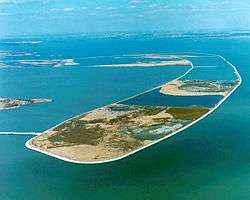
Michigan consists of two peninsulas that lie between east longitude, and are separated by the Straits of Mackinac, and some nearby islands. With the exception of two small areas that are drained by the Mississippi River by way of the Wisconsin River in the Upper Peninsula and by way of the Kankakee-Illinois River in the Lower Peninsula, Michigan is drained by the Great Lakes-St. Lawrence watershed and is the only state with the majority of its land thus drained.
Michigan encompasses 58,110 square miles (150,504 km²) of land, 38,575 square miles (99,909 km²) of Great Lakes waters and 1,305 square miles (3,380 km²) of inland waters. Only Alaska has more territorial water.[1] At a total of 97,990 square miles (253,793 km²), Michigan is the largest state east of the Mississippi River (inclusive of its territorial waters). Michigan has a total area of 96,716.11 sq mi (250,493.57 km2), making it the eleventh largest state. Michigan forestland covers nearly 52% of the land area of Michigan at 30,156 square miles (78,100 km2).
Great Lakes
The Great Lakes that border Michigan from east to west are Lake Erie, Lake Huron, Lake Michigan, and Lake Superior. Because of the lakes, Michigan has more lighthouses than any other state. The state is bounded on the south by the states of Ohio and Indiana, sharing land and water boundaries with both.
Michigan's northern boundaries are almost entirely water boundaries, from south to north, with Illinois and Wisconsin in Lake Michigan; then a land boundary with Wisconsin and the Upper Peninsula, that is principally demarcated by the Menominee and Montreal Rivers; then water boundaries again, in Lake Superior, with Wisconsin and Minnesota to the west, capped around by the Canadian province of Ontario to the north and east.
The northern boundary then runs completely through Lake Superior, from the western boundary with Minnesota to a point north of and around Isle Royale, thence traveling southeastward through the lake in a reasonably straight line to the Sault Ste. Marie area. In Southeastern Michigan there is a water boundary with Canada along the entire lengths of the St. Clair River, Lake St. Clair (including the First Nation reserve of Walpole Island) and the Detroit River. The southeastern boundary ends in the western end of Lake Erie with a three-way convergence of Michigan, Ohio and Ontario.
Upper Peninsula

The heavily forested Upper Peninsula is relatively mountainous in the west. The Porcupine Mountains, which are part of one of the oldest mountain chains in the world,[2] rise to an altitude of almost 2,000 feet (610 m) above sea level and form the watershed between the streams flowing into Lake Superior and Lake Michigan. The surface on either side of this range is rugged. The state's highest point, in the Huron Mountains northwest of Marquette, is Mount Arvon at 1,979 feet (603 m). The peninsula is as large as Connecticut, Delaware, Massachusetts, and Rhode Island combined but has fewer than 330,000 inhabitants. They are sometimes called "Yoopers" (from "U.P.'ers"), and their speech (the "Yooper dialect") has been heavily influenced by the numerous Scandinavian and Canadian immigrants who settled the area during the lumbering and mining boom of the late nineteenth century.
The geographic orientation of Michigan's peninsulas makes for a long distance between the ends of the state. Ironwood, in the far western Upper Peninsula, lies 630 highway miles (1,015 km) from Lambertville in the Lower Peninsula's southeastern corner. The geographic isolation of the Upper Peninsula from Michigan's political and population centers makes the U.P. culturally and economically distinct. Occasionally U.P. residents have called for secession from Michigan and establishment as a new state to be called "Superior."
Lower Peninsula
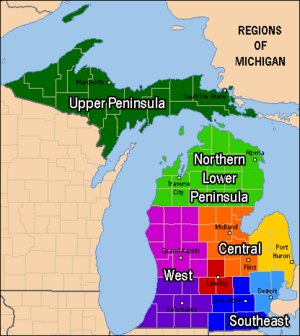
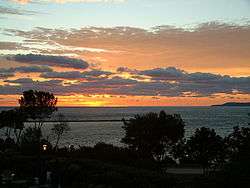
The Lower Peninsula, shaped like a mitten, is 277 miles (446 km) long from north to south and 195 miles (314 km) from east to west and occupies nearly two-thirds of the state's land area. The surface of the peninsula is generally level, broken by conical hills and glacial moraines usually not more than a few hundred feet tall. It is divided by a low water divide running north and south. The larger portion of the state is on the west of this and gradually slopes toward Lake Michigan. The highest point in the Lower Peninsula is either Briar Hill at 1,705 feet (520 m), or one of several points nearby in the vicinity of Cadillac. The lowest point is the surface of Lake Erie at 571 feet (174 m).
A feature of Michigan that gives it the distinct shape of a mitten is the Thumb. This peninsula projects out into Lake Huron and the Saginaw Bay. The geography of the Thumb is mainly flat with a few rolling hills. Other peninsulas of Michigan include the Keweenaw Peninsula, making up the Copper Country region of the state. The Leelanau Peninsula lies in the Northern Lower Michigan region. See Also Michigan Regions
Lakes and rivers
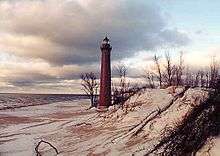
Numerous lakes and marshes mark both peninsulas, and the coast is much indented. Keweenaw Bay, Whitefish Bay, and the Big and Little Bays De Noc are the principal indentations on the Upper Peninsula. The Grand and Little Traverse, Thunder, and Saginaw bays indent the Lower Peninsula. After Alaska, Michigan has the longest shoreline of any state, 3,288 miles (5,292 km). An additional 1,056 miles (1,699 km) can be added if islands are included. This roughly equals the length of the Atlantic Coast from Maine to Florida.
The state has numerous large islands, the principal ones being the Manitou, Beaver, and Fox groups in Lake Michigan; Isle Royale and Grande Isle in Lake Superior; Drummond, Marquette, Bois Blanc, and Mackinac islands in Lake Huron; and Neebish and Sugar islands in St. Mary's River. Michigan has about 150 lighthouses, the most of any U.S. state. The first lighthouses in Michigan were built between 1818 and 1822. They were built to project light at night and to serve as a landmark during the day to safely guide the passenger ships and freighters traveling the Great Lakes. See Lighthouses in the United States.
The state's rivers are small, short and shallow, and few are navigable. The principal ones include the Au Sable, Thunder Bay, Cheboygan, and Saginaw, all of which flow into Lake Huron; the Ontonagon, and Tahquamenon, which flow into Lake Superior; and the St. Joseph, Kalamazoo, Grand, Muskegon, Manistee, and Escanaba, which flow into Lake Michigan. The state has 11,037 inland lakes and 38,575 square miles (99,909 km2) of Great Lakes waters and rivers in addition to 1,305 square miles (3,380 km2) of inland water. No point in Michigan is more than 6 miles (9.7 km) from an inland lake or more than 85 miles (137 km) from one of the Great Lakes.[3]
Protected areas
The state is home to one national park: Isle Royale National Park, located in Lake Superior, about 30 miles (48 km) southeast of Thunder Bay, Ontario. Other national protected areas in the state include: Keweenaw National Historical Park, Pictured Rocks National Lakeshore, Sleeping Bear Dunes National Lakeshore, Huron National Forest, Manistee National Forest, Hiawatha National Forest, Ottawa National Forest, Fumee Lake Natural Area and Father Marquette National Memorial. The largest section of the North Country National Scenic Trail also passes through Michigan.
With 78 state parks, 19 state recreation areas, and 6 state forests, Michigan has the largest state park and state forest system of any state. These parks and forests include Holland State Park, Mackinac Island State Park, Au Sable State Forest, and Mackinaw State Forest.
Climate

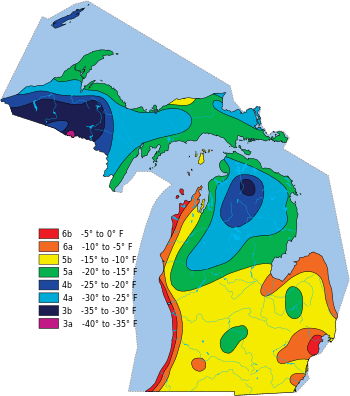
Michigan has a humid continental climate, although there are two distinct regions. The southern and central parts of the Lower Peninsula (south of Saginaw Bay and from the Grand Rapids area southward) have a warmer climate (Köppen climate classification Dfa) with hot summers and cold winters. The northern part of the Lower Peninsula and the entire Upper Peninsula has a more severe climate (Köppen Dfb), with warm, but shorter summers and longer, cold to very cold winters. Some parts of the state average high temperatures below freezing from December through February, and into early March in the far northern parts. During the winter through the middle of February the state is frequently subjected to heavy lake-effect snow. The state averages from 30-40 inches (75–100 cm) of precipitation annually.
The entire state averages 30 days of thunderstorm activity per year. These can be severe, especially in the southern part of the state. The state averages 17 tornadoes per year, which are more common in the extreme southern portion of the state. Portions of the southern border have been nearly as vulnerable historically as parts of Tornado Alley. Farther north, in the Upper Peninsula, tornadoes are rare.[4]
| Climate data for Detroit (DTW), 1981–2010 normals,[lower-alpha 1] extremes 1874–present[lower-alpha 2] | |||||||||||||
|---|---|---|---|---|---|---|---|---|---|---|---|---|---|
| Month | Jan | Feb | Mar | Apr | May | Jun | Jul | Aug | Sep | Oct | Nov | Dec | Year |
| Record high °F (°C) | 67 (19) |
70 (21) |
86 (30) |
89 (32) |
95 (35) |
104 (40) |
105 (41) |
104 (40) |
100 (38) |
92 (33) |
81 (27) |
69 (21) |
105 (41) |
| Mean maximum °F (°C) | 51.2 (10.7) |
54.6 (12.6) |
70.4 (21.3) |
80.1 (26.7) |
85.8 (29.9) |
92.2 (33.4) |
93.4 (34.1) |
92.0 (33.3) |
88.3 (31.3) |
79.7 (26.5) |
67.2 (19.6) |
54.4 (12.4) |
95.1 (35.1) |
| Average high °F (°C) | 32.0 (0) |
35.2 (1.8) |
45.8 (7.7) |
59.1 (15.1) |
69.9 (21.1) |
79.3 (26.3) |
83.4 (28.6) |
81.4 (27.4) |
74.0 (23.3) |
61.6 (16.4) |
48.8 (9.3) |
36.1 (2.3) |
59.0 (15) |
| Average low °F (°C) | 19.1 (−7.2) |
21.0 (−6.1) |
28.6 (−1.9) |
39.4 (4.1) |
49.4 (9.7) |
59.5 (15.3) |
63.9 (17.7) |
62.6 (17) |
54.7 (12.6) |
43.3 (6.3) |
34.3 (1.3) |
24.1 (−4.4) |
41.8 (5.4) |
| Mean minimum °F (°C) | −1.2 (−18.4) |
2.9 (−16.2) |
10.9 (−11.7) |
24.5 (−4.2) |
35.7 (2.1) |
45.8 (7.7) |
52.2 (11.2) |
51.2 (10.7) |
39.8 (4.3) |
29.7 (−1.3) |
19.7 (−6.8) |
5.4 (−14.8) |
−5.1 (−20.6) |
| Record low °F (°C) | −21 (−29) |
−20 (−29) |
−4 (−20) |
8 (−13) |
25 (−4) |
36 (2) |
42 (6) |
38 (3) |
29 (−2) |
17 (−8) |
0 (−18) |
−11 (−24) |
−21 (−29) |
| Average precipitation inches (mm) | 1.96 (49.8) |
2.02 (51.3) |
2.28 (57.9) |
2.90 (73.7) |
3.38 (85.9) |
3.52 (89.4) |
3.37 (85.6) |
3.00 (76.2) |
3.27 (83.1) |
2.52 (64) |
2.79 (70.9) |
2.46 (62.5) |
33.47 (850.1) |
| Average snowfall inches (cm) | 12.5 (31.8) |
10.2 (25.9) |
6.9 (17.5) |
1.7 (4.3) |
trace | 0 (0) |
0 (0) |
0 (0) |
0 (0) |
0.1 (0.3) |
1.5 (3.8) |
9.6 (24.4) |
42.5 (108) |
| Average precipitation days (≥ 0.01 in) | 13.1 | 10.6 | 11.7 | 12.2 | 12.1 | 10.2 | 10.4 | 9.6 | 9.5 | 9.8 | 11.6 | 13.7 | 134.5 |
| Average snowy days (≥ 0.1 in) | 10.4 | 8.3 | 5.4 | 1.6 | 0 | 0 | 0 | 0 | 0 | 0.2 | 2.3 | 8.5 | 36.7 |
| Average relative humidity (%) | 74.7 | 72.5 | 70.0 | 66.0 | 65.3 | 67.3 | 68.5 | 71.5 | 73.4 | 71.6 | 74.6 | 76.7 | 71.0 |
| Mean monthly sunshine hours | 119.9 | 138.3 | 184.9 | 217.0 | 275.9 | 301.8 | 317.0 | 283.5 | 227.6 | 176.0 | 106.3 | 87.7 | 2,435.9 |
| Percent possible sunshine | 41 | 47 | 50 | 54 | 61 | 66 | 69 | 66 | 61 | 51 | 36 | 31 | 55 |
| Source: NOAA (relative humidity and sun 1961–1990)[5][6][7] | |||||||||||||
| Climate data for Grand Rapids, Michigan (Gerald Ford Int'l), 1981–2010 normals, extremes 1892−present[lower-alpha 3] | |||||||||||||
|---|---|---|---|---|---|---|---|---|---|---|---|---|---|
| Month | Jan | Feb | Mar | Apr | May | Jun | Jul | Aug | Sep | Oct | Nov | Dec | Year |
| Record high °F (°C) | 68 (20) |
69 (21) |
87 (31) |
90 (32) |
95 (35) |
102 (39) |
108 (42) |
102 (39) |
98 (37) |
89 (32) |
81 (27) |
69 (21) |
108 (42) |
| Average high °F (°C) | 30.7 (−0.7) |
33.7 (0.9) |
44.4 (6.9) |
58.2 (14.6) |
69.5 (20.8) |
79.0 (26.1) |
82.8 (28.2) |
80.6 (27) |
73.0 (22.8) |
60.3 (15.7) |
47.3 (8.5) |
34.8 (1.6) |
57.9 (14.4) |
| Average low °F (°C) | 18.1 (−7.7) |
19.9 (−6.7) |
26.9 (−2.8) |
37.7 (3.2) |
47.8 (8.8) |
57.7 (14.3) |
62.2 (16.8) |
61.0 (16.1) |
52.7 (11.5) |
41.8 (5.4) |
33.0 (0.6) |
23.5 (−4.7) |
40.2 (4.6) |
| Record low °F (°C) | −22 (−30) |
−24 (−31) |
−13 (−25) |
3 (−16) |
21 (−6) |
32 (0) |
41 (5) |
39 (4) |
27 (−3) |
18 (−8) |
−10 (−23) |
−18 (−28) |
−24 (−31) |
| Average precipitation inches (mm) | 2.09 (53.1) |
1.79 (45.5) |
2.37 (60.2) |
3.35 (85.1) |
3.98 (101.1) |
3.77 (95.8) |
3.78 (96) |
3.59 (91.2) |
4.28 (108.7) |
3.26 (82.8) |
3.51 (89.2) |
2.50 (63.5) |
38.27 (972.1) |
| Average snowfall inches (cm) | 20.8 (52.8) |
14.8 (37.6) |
8.3 (21.1) |
1.8 (4.6) |
trace | 0 (0) |
0 (0) |
0 (0) |
0 (0) |
0.5 (1.3) |
6.8 (17.3) |
21.9 (55.6) |
74.9 (190.2) |
| Average precipitation days (≥ 0.01 in) | 16.0 | 12.2 | 11.8 | 12.7 | 11.2 | 10.1 | 9.7 | 9.6 | 10.7 | 11.8 | 13.2 | 16.0 | 145.0 |
| Average snowy days (≥ 0.1 in) | 14.9 | 10.7 | 6.4 | 2.0 | 0.1 | 0 | 0 | 0 | 0 | 0.5 | 4.2 | 13.3 | 52.1 |
| Average relative humidity (%) | 77.2 | 74.2 | 71.1 | 66.8 | 65.4 | 68.1 | 69.6 | 73.3 | 76.1 | 74.6 | 76.9 | 79.5 | 72.7 |
| Mean monthly sunshine hours | 88.3 | 116.0 | 168.2 | 210.2 | 255.9 | 286.8 | 296.5 | 264.2 | 206.0 | 152.4 | 82.0 | 62.1 | 2,188.6 |
| Percent possible sunshine | 30 | 39 | 45 | 52 | 56 | 62 | 64 | 61 | 55 | 45 | 28 | 22 | 49 |
| Source: NOAA (relative humidity and sun 1961−1990)[8][9][10] | |||||||||||||
| Climate data for Lansing, Michigan (Capital Region Int'l), 1981−2010 normals, extremes 1863−present[lower-alpha 4] | |||||||||||||
|---|---|---|---|---|---|---|---|---|---|---|---|---|---|
| Month | Jan | Feb | Mar | Apr | May | Jun | Jul | Aug | Sep | Oct | Nov | Dec | Year |
| Record high °F (°C) | 66 (19) |
69 (21) |
86 (30) |
88 (31) |
96 (36) |
99 (37) |
103 (39) |
102 (39) |
99 (37) |
90 (32) |
79 (26) |
70 (21) |
103 (39) |
| Average high °F (°C) | 30.1 (−1.1) |
33.3 (0.7) |
44.1 (6.7) |
57.8 (14.3) |
68.8 (20.4) |
78.4 (25.8) |
82.4 (28) |
80.1 (26.7) |
72.7 (22.6) |
59.9 (15.5) |
46.7 (8.2) |
34.3 (1.3) |
57.4 (14.1) |
| Daily mean °F (°C) | 23.4 (−4.8) |
25.9 (−3.4) |
35.1 (1.7) |
47.4 (8.6) |
57.7 (14.3) |
67.6 (19.8) |
71.5 (21.9) |
69.8 (21) |
61.9 (16.6) |
50.3 (10.2) |
39.6 (4.2) |
28.3 (−2.1) |
48.2 (9.0) |
| Average low °F (°C) | 16.8 (−8.4) |
18.5 (−7.5) |
26.0 (−3.3) |
37.0 (2.8) |
46.7 (8.2) |
56.7 (13.7) |
60.6 (15.9) |
59.4 (15.2) |
51.2 (10.7) |
40.7 (4.8) |
32.4 (0.2) |
22.3 (−5.4) |
39.0 (3.9) |
| Record low °F (°C) | −29 (−34) |
−37 (−38) |
−25 (−32) |
−6 (−21) |
19 (−7) |
27 (−3) |
31 (−1) |
26 (−3) |
19 (−7) |
10 (−12) |
−5 (−21) |
−25 (−32) |
−37 (−38) |
| Average precipitation inches (mm) | 1.65 (41.9) |
1.47 (37.3) |
2.06 (52.3) |
3.03 (77) |
3.36 (85.3) |
3.45 (87.6) |
2.84 (72.1) |
3.23 (82) |
3.50 (88.9) |
2.53 (64.3) |
2.78 (70.6) |
1.87 (47.5) |
31.77 (807) |
| Average snowfall inches (cm) | 13.8 (35.1) |
11.6 (29.5) |
7.0 (17.8) |
1.9 (4.8) |
trace | 0 (0) |
0 (0) |
0 (0) |
0 (0) |
0.4 (1) |
3.4 (8.6) |
13.0 (33) |
51.1 (129.8) |
| Average precipitation days (≥ 0.01 in) | 13.4 | 10.6 | 11.2 | 12.1 | 11.6 | 10.3 | 9.5 | 9.9 | 10.7 | 10.9 | 12.7 | 13.9 | 136.8 |
| Average snowy days (≥ 0.1 in) | 12.5 | 9.8 | 5.8 | 1.8 | 0 | 0 | 0 | 0 | 0 | 0.3 | 3.7 | 10.8 | 44.7 |
| Average relative humidity (%) | 78.8 | 76.2 | 73.3 | 67.6 | 66.7 | 69.0 | 71.0 | 74.9 | 77.5 | 76.1 | 78.6 | 81.1 | 74.2 |
| Mean monthly sunshine hours | 118.2 | 140.1 | 187.6 | 218.7 | 278.6 | 296.2 | 318.5 | 278.1 | 217.6 | 163.8 | 92.4 | 82.1 | 2,391.9 |
| Percent possible sunshine | 40 | 47 | 51 | 54 | 61 | 65 | 69 | 65 | 58 | 48 | 32 | 29 | 54 |
| Source: NOAA (relative humidity and sun 1961−1990)[11][12][13] | |||||||||||||
| Climate data for Marquette, Michigan | |||||||||||||
|---|---|---|---|---|---|---|---|---|---|---|---|---|---|
| Month | Jan | Feb | Mar | Apr | May | Jun | Jul | Aug | Sep | Oct | Nov | Dec | Year |
| Record high °F (°C) | 57 (14) |
69 (21) |
82 (28) |
91 (33) |
100 (38) |
101 (38) |
108 (42) |
102 (39) |
98 (37) |
89 (32) |
74 (23) |
60 (16) |
108 (42) |
| Average high °F (°C) | 25.0 (−3.9) |
27.8 (−2.3) |
35.9 (2.2) |
47.3 (8.5) |
59.4 (15.2) |
68.3 (20.2) |
74.5 (23.6) |
74.2 (23.4) |
66.8 (19.3) |
53.9 (12.2) |
40.3 (4.6) |
29.1 (−1.6) |
50.2 (10.1) |
| Daily mean °F (°C) | 13.6 (−10.2) |
15.5 (−9.2) |
24.2 (−4.3) |
37.9 (3.3) |
50.9 (10.5) |
60.6 (15.9) |
65.5 (18.6) |
63.7 (17.6) |
55.8 (13.2) |
43.2 (6.2) |
30.3 (−0.9) |
18.5 (−7.5) |
40.0 (4.4) |
| Average low °F (°C) | 12.5 (−10.8) |
13.6 (−10.2) |
22.1 (−5.5) |
32.9 (0.5) |
42.6 (5.9) |
51.5 (10.8) |
58.6 (14.8) |
59.0 (15) |
52.0 (11.1) |
40.6 (4.8) |
29.3 (−1.5) |
18.0 (−7.8) |
36.1 (2.3) |
| Record low °F (°C) | −26 (−32) |
−33 (−36) |
−19 (−28) |
3 (−16) |
16 (−9) |
29 (−2) |
36 (2) |
33 (1) |
22 (−6) |
12 (−11) |
−9 (−23) |
−20 (−29) |
−33 (−36) |
| Average precipitation inches (mm) | 1.80 (45.7) |
1.31 (33.3) |
2.01 (51.1) |
2.33 (59.2) |
2.56 (65) |
2.67 (67.8) |
2.66 (67.6) |
2.63 (66.8) |
3.31 (84.1) |
3.14 (79.8) |
2.63 (66.8) |
1.95 (49.5) |
28.98 (736.1) |
| Average snowfall inches (cm) | 32.0 (81.3) |
26.6 (67.6) |
24.6 (62.5) |
10.5 (26.7) |
1.5 (3.8) |
0 (0) |
0 (0) |
0 (0) |
0.2 (0.5) |
4.3 (10.9) |
18.3 (46.5) |
31.7 (80.5) |
149.1 (378.7) |
| Average precipitation days (≥ 0.01 in) | 17.3 | 11.4 | 11.9 | 10.5 | 10.3 | 11.4 | 10.8 | 10.8 | 13.1 | 13.8 | 13.6 | 15.0 | 150.0 |
| Average snowy days (≥ 0.1 in) | 18.6 | 12.3 | 10.1 | 4.4 | 0.2 | 0 | 0 | 0 | 0.1 | 0.8 | 7.7 | 14.7 | 68.8 |
| Mean monthly sunshine hours | 105.5 | 128.8 | 181.3 | 225.3 | 278.8 | 289.7 | 322.8 | 270.6 | 191.5 | 140.6 | 80.7 | 78.2 | 2,293.8 |
| Source: NOAA (normals 1981–2010, sun 1961–1990, extremes 1860–present)[14][15][16] | |||||||||||||
| Climate data for Sault Ste. Marie, Michigan (1981–2010 normals, extremes 1888–present) | |||||||||||||
|---|---|---|---|---|---|---|---|---|---|---|---|---|---|
| Month | Jan | Feb | Mar | Apr | May | Jun | Jul | Aug | Sep | Oct | Nov | Dec | Year |
| Record high °F (°C) | 54 (12) |
50 (10) |
83 (28) |
85 (29) |
91 (33) |
93 (34) |
98 (37) |
98 (37) |
95 (35) |
82 (28) |
74 (23) |
62 (17) |
98 (37) |
| Average high °F (°C) | 23.0 (−5) |
25.9 (−3.4) |
34.7 (1.5) |
49.4 (9.7) |
62.7 (17.1) |
71.3 (21.8) |
76.2 (24.6) |
74.7 (23.7) |
66.5 (19.2) |
53.3 (11.8) |
40.1 (4.5) |
28.6 (−1.9) |
50.53 (10.3) |
| Average low °F (°C) | 7.6 (−13.6) |
9.4 (−12.6) |
17.9 (−7.8) |
31.1 (−0.5) |
40.9 (4.9) |
48.7 (9.3) |
54.4 (12.4) |
54.5 (12.5) |
47.7 (8.7) |
37.8 (3.2) |
28.1 (−2.2) |
15.8 (−9) |
32.83 (0.44) |
| Record low °F (°C) | −36 (−38) |
−37 (−38) |
−27 (−33) |
−13 (−25) |
18 (−8) |
26 (−3) |
36 (2) |
29 (−2) |
25 (−4) |
15 (−9) |
−12 (−24) |
−31 (−35) |
−37 (−38) |
| Average precipitation inches (mm) | 2.19 (55.6) |
1.34 (34) |
1.95 (49.5) |
2.39 (60.7) |
2.57 (65.3) |
2.70 (68.6) |
2.86 (72.6) |
3.17 (80.5) |
3.82 (97) |
3.80 (96.5) |
3.37 (85.6) |
2.79 (70.9) |
32.95 (836.8) |
| Average snowfall inches (cm) | 31.4 (79.8) |
18.6 (47.2) |
13.4 (34) |
6.7 (17) |
0.1 (0.3) |
0 (0) |
0 (0) |
0 (0) |
trace | 1.6 (4.1) |
15.1 (38.4) |
33.5 (85.1) |
120.4 (305.8) |
| Average precipitation days (≥ 0.01 in) | 18.4 | 13.0 | 12.3 | 10.9 | 11.2 | 11.1 | 11.2 | 10.9 | 12.9 | 15.5 | 16.7 | 18.8 | 162.9 |
| Average snowy days (≥ 0.1 in) | 19.6 | 14.2 | 10.1 | 4.6 | 0.4 | 0 | 0 | 0 | 0.1 | 2.2 | 10.0 | 18.0 | 79.2 |
| Mean monthly sunshine hours | 104.9 | 142.5 | 206.4 | 227.5 | 280.3 | 281.2 | 303.6 | 248.9 | 172.9 | 122.6 | 70.4 | 77.4 | 2,238.6 |
| Source: NOAA (sun 1961–1990)[17][18] | |||||||||||||
Geology

The geological formation of the state is greatly varied. Primary boulders are found over the entire surface of the Upper Peninsula (being principally of primitive origin), while Secondary deposits cover the entire Lower Peninsula. The Upper Peninsula exhibits Lower Silurian sandstones, limestones, copper and iron bearing rocks, corresponding to the Huronian system of Canada. The central portion of the Lower Peninsula contains coal measures and rocks of the Permo-Carboniferous period. Devonian and sub-Carboniferous deposits are scattered over the entire state.
The soil is of a varied composition and in large areas is very fertile, especially in the south. However, the Upper Peninsula for the most part is rocky and mountainous, and the soil is unsuitable for agriculture. The climate is tempered by the proximity of the lakes and is much milder than in other locales with the same latitude. The principal forest trees include basswood, maple, elm, sassafras, butternut, walnut, poplar, hickory, oak, willow, pine, birch, beech, hemlock, witchhazel, tamarack, cedar, locust, dogwood, and ash.
Notes
- ↑ Mean monthly maxima and minima (i.e. the highest and lowest temperature readings during an entire month or year) calculated based on data at said location from 1981 to 2010.
- ↑ Official records for Detroit were kept at downtown from January 1874 to December 1933, Detroit City Airport from February 1934 to March 1966, and at DTW since April 1966. For more information, see ThreadEx.
- ↑ Official records for Grand Rapids kept June 1892 to December 1940 at downtown, at the first Grand Rapids Airport some 4 mi (6.4 km) south of downtown from January 1941 to 23 November 1963, and at Gerald Ford Int'l since its opening on 24 November 1963. For more information, see Threadex
- ↑ Official records for Lansing were kept in East Lansing from April 1863 to April 1948, Capital Region Int'l from May 1948 to July 1954, East Lansing again from August 1954 to April 1959, and again at Capital Region Int'l since May 1959. For more information, see ThreadEx.
References
- ↑ "Land and Water Area of States, 2000".
- ↑ "Michigan Dept. of Natural Resources".
- ↑ "Michigan Tourism Facts". Michigan Economic Development Corporation. Retrieved July 25, 2016.
- ↑ "Archived copy". Archived from the original on October 15, 2006. Retrieved October 25, 2006. srh.noaa.gov. Last accessed November 1, 2006.
- ↑ "NOWData – NOAA Online Weather Data/". National Oceanic and Atmospheric Administration. Retrieved 2016-04-12.
- ↑ "Station Name: MI DETROIT METRO AP". National Oceanic and Atmospheric Administration. Retrieved 2013-03-19.
- ↑ "Detroit/Metropolitan ARPT MI Climate Normals 1961–1990". National Oceanic and Atmospheric Administration. Retrieved May 12, 2013.
- ↑ "NowData - NOAA Online Weather Data". National Oceanic and Atmospheric Administration. Retrieved 2012-02-08.
- ↑ "Station Name: MI GRAND RAPIDS". National Oceanic and Atmospheric Administration. Retrieved 2014-03-30.
- ↑ "WMO Climate Normals for GRAND RAPIDS/KENT CO INT'L AR,MI 1961–1990". National Oceanic and Atmospheric Administration. Retrieved 2014-03-10.
- ↑ "NowData - NOAA Online Weather Data". National Oceanic and Atmospheric Administration. Retrieved 2012-02-15.
- ↑ "Station Name: MI LANSING CAPITAL CITY AP". National Oceanic and Atmospheric Administration. Retrieved 2014-03-30.
- ↑ "WMO Climate Normals for LANSING/CAPITAL CITY AP, MI 1961–1990". National Oceanic and Atmospheric Administration. Retrieved 2014-03-30.
- ↑ "NOWData: NOAA Online Weather Data". National Oceanic and Atmospheric Administration. Retrieved May 9, 2013.
- ↑ "Comparative Climate Data For the United States Through 2012" (PDF). National Oceanic and Atmospheric Administration. p. 56. Archived from the original (PDF) on July 18, 2014. Retrieved December 6, 2014.
- ↑ "Marquette/FAA ARPT MI Climate Normals 1961–1990". National Oceanic and Atmospheric Administration. Retrieved May 9, 2013.
- ↑ "NOWData – NOAA Online Weather Data". National Oceanic and Atmospheric Administration. Retrieved May 10, 2013.
- ↑ "Sault STE. MARIE, MI Climate Normals 1961–1990". National Oceanic and Atmospheric Administration. Retrieved May 10, 2013.

